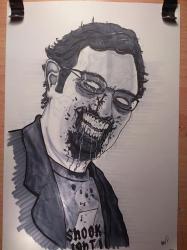
The record of the Alien franchise hasn’t been that great since 1986.
Alien³ was famously butchered in post-production, much to director David Fincher’s anger; Alien Resurrection is just downright awful; and the less said about the Alien v Predator movies the better. Prometheus, for all its promise, never lived up to either its predecessors or its own potential. So frankly the best instalment in this franchise since the mid-80s has been the epic video game Alien Isolation. But, with Ridley Scott’s latest attempt to revisit this universe proving a mixed blessing at best, how does the original still stack up after almost forty years?
What would become one of the most acclaimed sci-fi/horror movies of all time started out in the imagination of Dan O’Bannon in the 1970s. After penning the script for student film-turned-directorial debut of John Carpenter, the stoners-in-space Dark Star, O’Bannon decided that he really wanted to do a film with an alien that looked real. Having been shot on a budget of roughly 10p, Dark Star’s alien life form consisted of a beach ball with a pair of flippers glued to it and the writer was convinced he could do better. Over time, the idea developed into one for an alien creature stalking the crew of a space ship, and shifted from comedy to horror. O’Bannon began playing around with the concept with fellow writer Ronald Shusett, until the two went their separate ways to work on other projects. After those projects fell through, the writers started working on O’Bannon’s concept again, by now going under the working title of Memory.
At this point the story essentially told the first two acts of what would eventually become Alien: a human crew sets down on an uninhabited planet and the crew is infiltrated by an extraterrestrial creature that begins picking them off one by one. Shusett suggested adapting an idea O’Bannon had previously pitched, featuring gremlins infiltrating and sabotaging a World War II B-17 bomber mid-flight, and the idea became the last part of the script, which by now was known as Star Beast. O’Bannon thought it was a stupid title and, after noting the number of times the word ‘alien’ cropped up in the script, changed it to Alien. The pair were still uncertain about how said alien got onto the ship, until Shusett came up with the idea that one of the crew was implanted with an embryo that would hatch into the creature. O’Bannon would eventually note the essentially adaptational nature of the script, in that the plot was made up of tropes previously pioneered in other movies such as Forbidden Planet, The Thing From Another World (ironically later remade by his old friend John Carpenter as 1982’s The Thing) and Planet of the Vampires, stating, “I didn’t steal Alien from anybody… I stole it from everybody!”
The script now roughly four-fifths complete, the two writers pitched it to several studios as “Jaws in space”. They were on the verge of doing a deal with schlock-meister Roger Corman’s New World Pictures until a friend offered them an opportunity to pitch the script to a major studio. They signed a deal with production company Brandywine Productions, which had ties to 20th Century Fox, in early 1977. Trouble set in fairly early on, with Brandywine’s David Giler and Walter Hill making a lot of changes to the script, to O’Bannon’s fury. Furthermore, Fox were not convinced science fiction could be profitable and would only propose a miniscule budget. Fortunately, the success of Star Wars changed the studio’s mind and Alien, complete with Hill and Giler’s android character Ash, was greenlit.
O’Bannon assumed that he would direct; Fox wanted Hill, but he had other commitments. After numerous directors were linked with the project, it was offered to Ridley Scott, fresh off his directorial debut The Duelists. Scott readily signed on, and his enthusiasm for the project persuaded Fox to double the budget. A cast was quickly assembled, with the roles all being defined as unisex: no one role was specifically male or female, and nobody had a first name accordingly. Initially, John Hurt had to decline the role of Kane due to a scheduling conflict; however, when his replacement Jon Finch became ill on-set, the now free Hurt was brought in as a replacement. It has been noted that the male cast were all in their 40s or 50s (aside from Hurt, who still looked much older than his 39 years), with only Veronica Cartwright and Sigourney Weaver being in the usual late 20s/early 30s age range for thriller casts. This fit in with the aesthetic that Scott and the producers were aiming for: that of truckers in space, hauling around millions of tons of oil or minerals.
O’Bannon had been introduced to Swiss surrealist artist HR Giger when the two were working on an abortive film version of Dune in the mid-70s. Giger’s work would provide inspiration to the creature in O’Bannon’s mind. He showed Scott Giger’s painting Necronom IV as the sort of thing he had in mind. Scott agreed, and hired the artist to work on all the alien aspects of the movie. Giger was given free rein over the creature designs and the derelict ship the crew would investigate. The human ship Nostromo, on the other hand, was given over to production designer Ron Cobb and the visual effects team headed by supervisor Brian Johnson and modelmaker Martin Bower. Cobb created designs for the interior of the ship to seem like a hotch-potch of different technologies. On the one hand, the sickbay, suspended animation and crew rest areas were almost clinically clean and modern, while the rest of the ship was full of dated (even for 1978) consoles and decaying metalwork. An extension of the truckers-in-space theme, Cobb wanted to show a ship that had seen better days and just been refitted with new technology when bits wore out.
The visual effects team put together a series of designs for the Nostromo and its associated peripherals, based on Scott’s own storyboards and concept art provided by Cobb. As with Star Wars, the designs were detailed with parts from various plastic model kits. Ironically, parts were also used from Star Wars kits, with elements such as R2-D2’s leg and TIE fighter solar panels making it onto the finished product. Giger’s designs brought a disturbingly biological feel to the film, with Veronica Cartwright describing them as borderline erotic. In order to keep within the budget, only one wall of the derelict spacecraft’s interior was built. A combination of forced perspective and shifting the props around on-set gave the illusion that a larger set existed. The production was rounded off by the discovery of rail-thin, 6 foot 10 Nigerian graphic design student Bolaji Badejo in a London bar by a member of the casting team. After being put in touch with Ridley Scott, the director decided he was perfect to fit inside Giger’s creature costume.
Everything finally seemed to be coming together. Principal photography started at Shepperton on 5 July 1978, and crap went downhill fast. Scott was convinced that the extensive sets for the derelict interior and Nostromo landing gear weren’t big enough. He then put his two young sons and the son of cinematographer Derek Vanlint in miniature spacesuits to act out scenes on these sets in place of Cartwright, Hurt and Tom Skerrit, but the children nearly passed out through heat exhaustion in the bulky, uncooled costumes. Aside from Jon Finch’s brush with hypoglycaemia on set that necessitated his replacement with Hurt, Weaver proved to be allergic to a combination of cat dander and the glycerine put on actors’ faces to simulate sweat, rendering scenes with ship’s cat Jones near-impossible to shoot. Method actor Yaphet Kotto, playing engineer Parker, frequently clashed with non-actor Badejo for the latter’s apparent lack of professionalism. Scott angered the effects team when, after six weeks of shooting the miniatures, he decided that he wanted the Nostromo painting grey instead of its original yellow. To pile even more fury onto the effects team, the director proceeded to attack the huge refinery model with a hammer and chisel, knocking bits off until it was to his liking. Scenes scripted were either changed or dropped part-way through, with Scott approaching the studio for extra money to shoot an extended ending of the Alien stowing away on Ripley’s escape shuttle, what he describes as a “fourth act”.
Yet despite these problems and more, the end product was received extremely well by critics, science fiction fans and horror fans alike. Alien is a constant fixture in articles on the best SF or horror movies ever made, topping many, with critics frequently arguing whether Alien or Blade Runner is Scott’s best work. So, the question is: with the numerous production issues, protracted development and battles on and off set, can such a film still hold up? Is it the classic people remember, or just a bog-standard haunted house movie somehow set in space?
The simple answer is: yes. It holds up. With the release of a director’s cut as part of the clunkily-titled Alien Quadrilogy box set, we got to see a couple of the deleted scenes restored, and it’s arguable whether they improve the film at all. Certainly, the scene of Ripley finding the cocooned Dallas, alongside Brett’s corpse that was being used as the food source for a growing egg, is as creepy as I imagined it from Alan Dean Foster’s novelisation. But the one key scene that would’ve added so much, one of Parker trying to flush the Alien out of an airlock when Ash sets off an alarm to scare it away and keep it alive, was never even finished when Scott decided to drop it. So it’s a simple question of preference: both versions are fantastic, and not too different. They still scare the bejezus out of me, and frankly Alien is still the only horror movie to still do that after repeated viewings. That scene with Dallas being chased through the air vents… Ye gods, still sends a shiver down my spine.
The on-set stories of Scott’s almost cavalier attitude to film-making have become legendary. Aside from nearly killing three actors and three kids in unventilated space suits, Scott didn’t bother warning the cast about the high-pressure jets of blood fitted in the fake torso used in the chestburster scene. When one jet hit Veronica Cartwright straight in the face, she recoiled in full freakout mode and Scott just kept the cameras rolling because he thought her reaction was authentic. Yet despite all its faults, its hellish development and production, and the dubious quality of most of the movies that would follow it (seriously, find the special edition of Alien³ – it’s so much better than the original), Alien stands as one of the best science fiction or horror movies ever made.
5 out of 5 Nerds






Nerd Comments